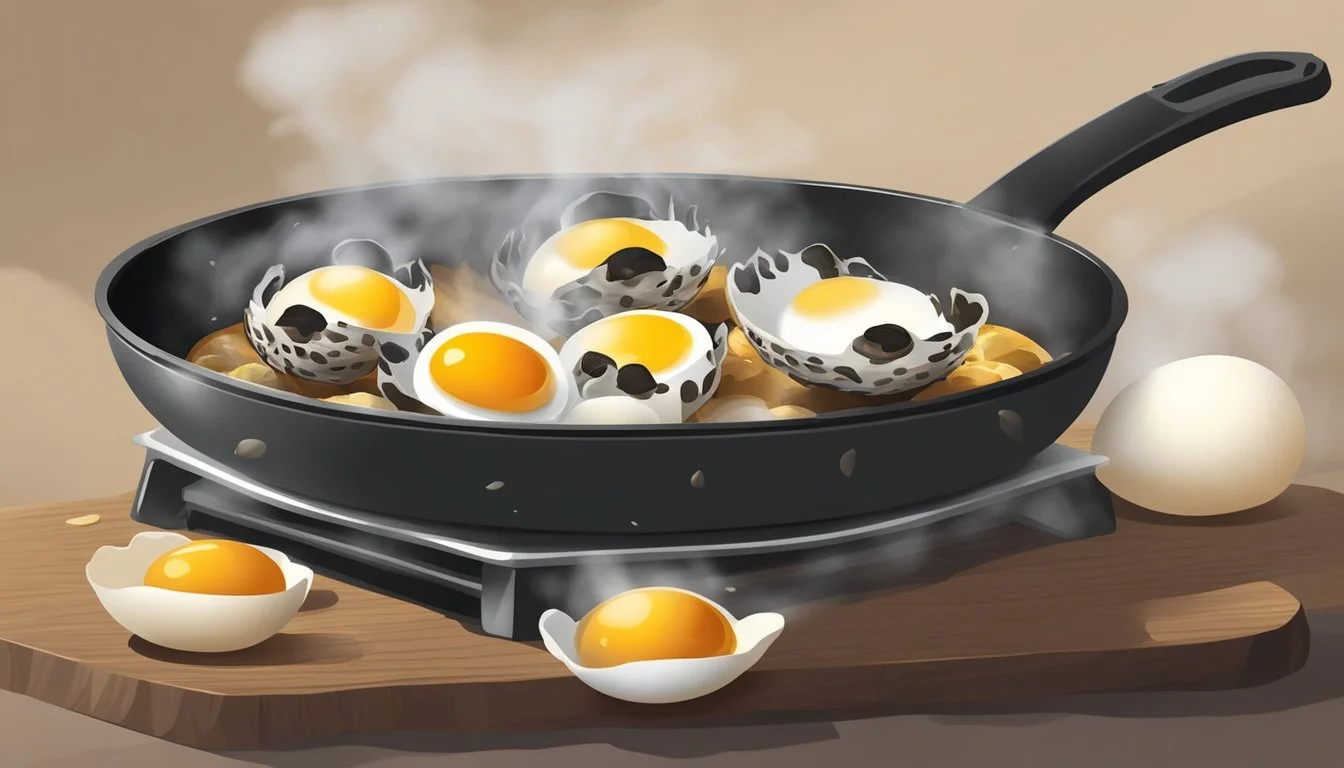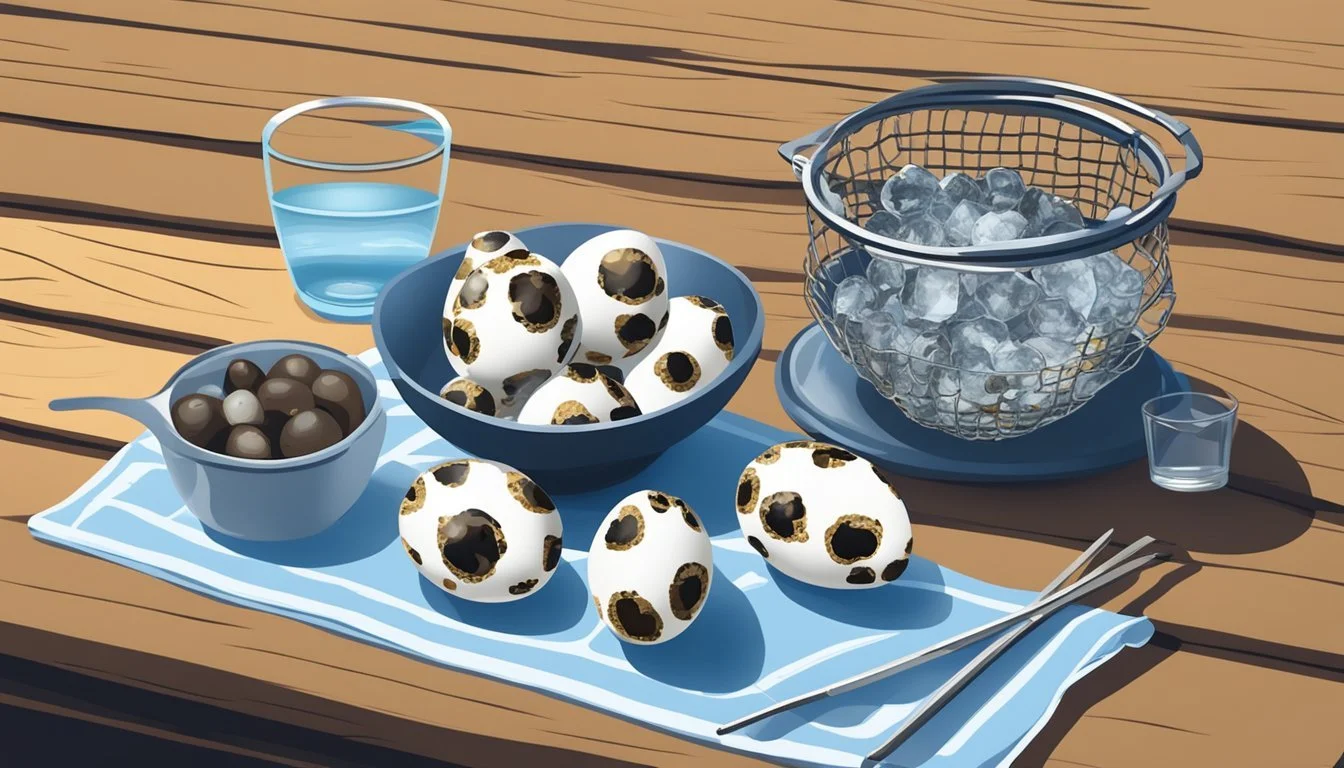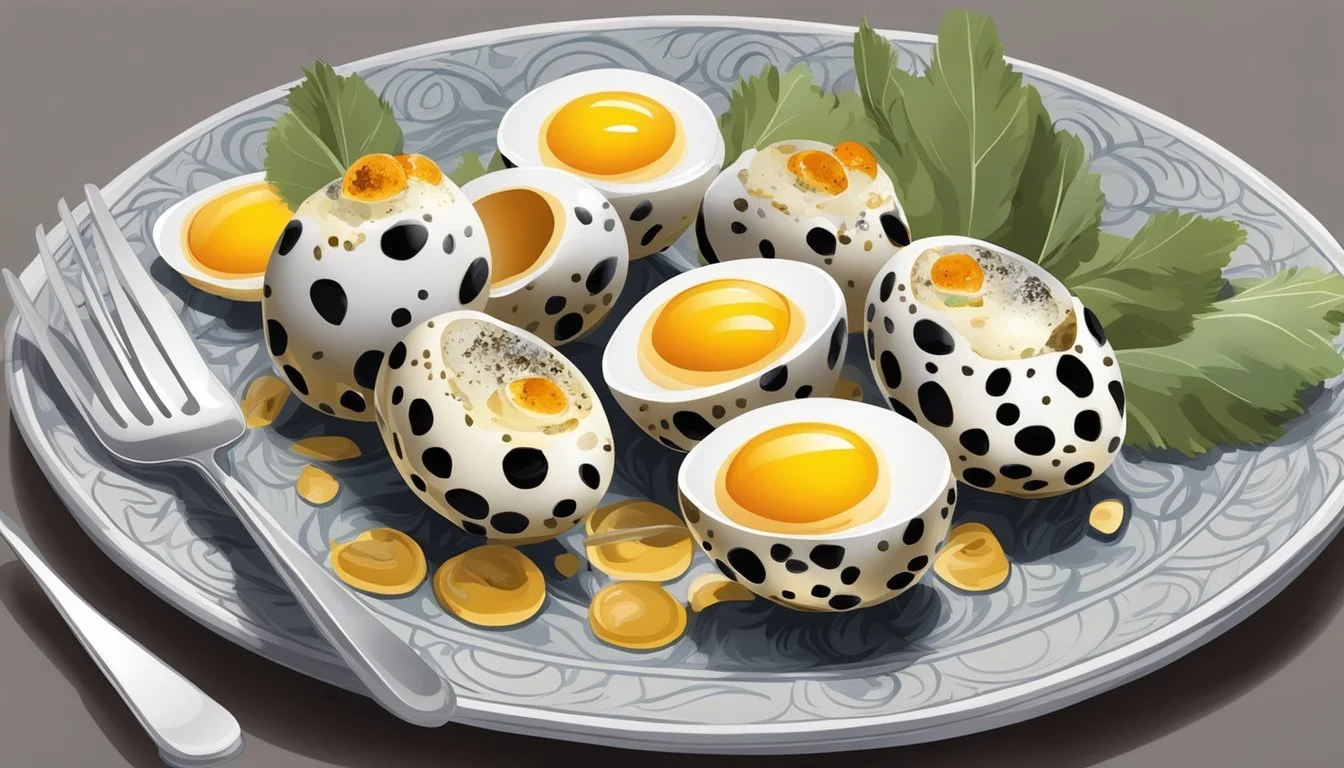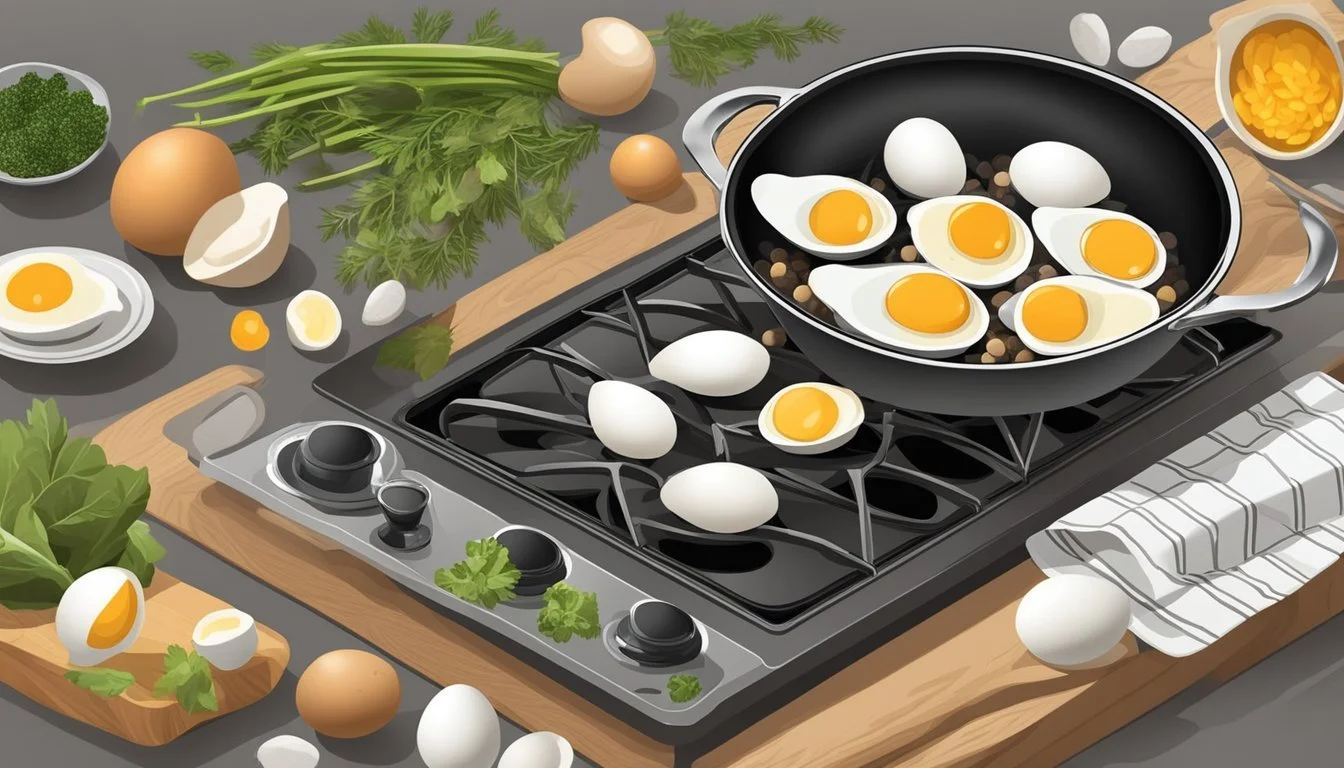How to Cook Quail Eggs
Delicate Delicacies Made Simple
Quail eggs are tiny culinary gems that pack a flavorful punch. These petite eggs measure about one-fifth the size of chicken eggs but offer a rich, creamy taste. Quail eggs contain high amounts of protein, iron, riboflavin, and vitamin B12, making them a nutritious addition to many dishes.
Cooking quail eggs requires precision due to their small size. Common methods include boiling, frying, and poaching. Boiling quail eggs takes only 2-3 minutes for soft-boiled and 3-4 minutes for hard-boiled. When frying, these delicate eggs cook quickly and develop crispy edges within a minute or two.
Quail eggs can elevate various recipes with their unique appearance and taste. They make elegant appetizers when served on toast points or add a gourmet touch to salads and canapés. Their compact size also allows for creative presentations in deviled egg dishes or as miniature versions of classic egg preparations.
Selecting Fresh Quail Eggs
Choosing high-quality quail eggs is essential for optimal flavor and safety. Proper selection ensures the best culinary results whether boiling, frying, or using them in recipes.
Identifying Freshness
Check the shell for cracks or damage. Fresh quail eggs have smooth, clean shells without blemishes. Hold the egg up to light - fresh eggs appear more opaque with a small air pocket visible at the wider end.
Gently shake the egg near your ear. Fresh eggs make little to no sound due to a firm yolk and white. A sloshing noise indicates an older egg.
Perform a float test by placing eggs in water. Fresh eggs sink and lay flat on their sides. Older eggs stand upright or float, signaling larger air pockets and decreased freshness.
Understanding Egg Grades
Quail eggs are typically graded based on size and quality. Grade A eggs are the highest quality, with clean, unbroken shells and firm whites. These are ideal for poaching or frying.
Grade B eggs may have slight shell defects or flatter yolks. They work well for hard boiling or in baked goods. Avoid eggs with visible cracks or leaks, as these pose food safety risks.
Size grades for quail eggs are less standardized than chicken eggs. Generally, larger eggs are preferred for eating whole, while smaller ones work well in recipes or as garnishes.
Storage and Preparation
Proper storage and preparation are crucial for maintaining the quality and safety of quail eggs. These steps ensure optimal freshness and set the stage for successful cooking.
Storing Quail Eggs
Store quail eggs in an airtight container in the refrigerator. This protects their delicate shells and prevents odor absorption.
Keep eggs in their original carton or a covered container. The carton helps maintain humidity and prevents moisture loss.
Refrigerate at 40°F (4°C) or below. Properly stored, quail eggs can last up to 6 weeks.
Avoid washing eggs before storage. The natural coating on the shell helps preserve freshness.
Check eggs regularly for cracks or signs of spoilage. Discard any that smell off or have a slimy appearance.
Preparation Essentials
Handle quail eggs gently due to their fragile shells. Wash hands thoroughly before and after handling raw eggs.
To crack, gently tap the egg on a flat surface and carefully separate the shell halves.
For boiling, bring water to a gentle boil. Add a pinch of salt to help prevent cracking and ease peeling.
Use a slotted spoon to carefully lower eggs into water. This minimizes the risk of cracking.
For fried or poached eggs, crack into a small bowl first. This allows for easy inspection and removal of shell fragments.
Season with salt and pepper after cooking to enhance flavor without affecting texture.
Cooking Quail Eggs
Quail eggs are delicate and versatile, offering a unique flavor and texture. They can be prepared using various methods, each highlighting their distinct qualities. Proper cooking techniques ensure the best taste and texture.
Boiling Techniques
To boil quail eggs, start by gently placing them in a saucepan of cold water. Bring the water to a boil over medium-high heat. For soft-boiled eggs, cook for 2 minutes. Hard-boiled eggs require 2 minutes and 30 seconds to 3 minutes.
After cooking, immediately transfer the eggs to a bowl of ice water to stop the cooking process. This helps prevent overcooking and makes peeling easier.
When peeling, gently crack the shell all over and roll the egg between your palms. Start peeling from the larger end, where the air pocket is located.
Frying Methods
Frying quail eggs requires a delicate touch due to their small size. Heat a non-stick pan over medium-low heat and add a small amount of butter or oil.
Carefully crack the eggs into small bowls before adding them to the pan. This prevents shell fragments and allows for easier handling.
For sunny-side up, cook for about 1-2 minutes until the whites are set but the yolks remain runny. For over-easy, flip the eggs gently and cook for an additional 30 seconds.
Other Cooking Methods
Poaching is another excellent method for cooking quail eggs. Fill a pan with water and add a splash of vinegar. Bring to a gentle simmer. Crack the eggs into small cups, then slide them into the water.
Cook for about 1-2 minutes until the whites are set but the yolks are still soft. Remove with a slotted spoon and drain on paper towels.
Quail eggs can also be baked in ramekins or used in frittatas and quiches. When baking, watch them closely as they cook faster than chicken eggs.
Special Cooking Techniques
Quail eggs can be prepared using various methods to achieve different textures and flavors. These techniques allow cooks to create unique dishes and presentations with these tiny, delicate eggs.
Soft Boiling Quail Eggs
Soft boiling quail eggs produces a runny yolk with a firm white. Place eggs in a pot of cold water. Bring to a boil over medium-high heat. Once boiling, remove from heat and cover. Let sit for 2 minutes.
Immediately transfer eggs to an ice bath to stop cooking. Gently crack and peel the shell. The white should be set while the yolk remains liquid.
Soft boiled quail eggs make an elegant topping for salads or toast. They can also be served in egg cups as a luxurious breakfast item.
Hard Boiling Quail Eggs
Hard boiled quail eggs have a fully cooked, firm yolk. Place eggs in a pot and cover with cold water. Bring to a boil over medium-high heat. Once boiling, reduce heat to low and simmer for 2-3 minutes.
Remove from heat and place eggs in an ice bath for 5 minutes. Gently roll eggs on a hard surface to crack shells. Peel under cool running water.
Hard boiled quail eggs can be used in salads, as garnishes, or eaten as a protein-rich snack. Their small size makes them perfect for appetizers or hors d'oeuvres.
Making Poached Quail Eggs
Poaching creates tender eggs with a silky texture. Bring a pot of water to a gentle simmer. Add a splash of vinegar to help the egg whites coagulate.
Crack each quail egg into a small bowl. Stir the water to create a gentle whirlpool. Carefully slide the egg into the center of the whirlpool. Cook for 1-2 minutes until whites are set but yolk is still runny.
Remove with a slotted spoon and drain on paper towels. Poached quail eggs are delicious on toast, salads, or as a topping for soups and vegetable dishes.
Creating Pickled Quail Eggs
Pickling extends the shelf life of quail eggs and infuses them with tangy flavor. Start with hard boiled and peeled quail eggs. Prepare a brine using vinegar, water, salt, and spices like peppercorns, dill, or garlic.
Place eggs in sterilized jars. Pour hot brine over eggs, ensuring they are fully submerged. Seal jars and refrigerate for at least 1 week before eating.
Pickled quail eggs make a flavorful snack or garnish. They can be sliced and added to salads or served whole as part of a charcuterie board. The pickling process turns the egg whites slightly rubbery with a tangy, salty flavor.
Cracking and Peeling
Cracking and peeling quail eggs requires precision and care due to their small size. The right techniques can make this process easier and help preserve the delicate yolks.
Best Practices for Cracking Quail Eggs
Using the right tools is crucial for cracking quail eggs. A quail egg scissor or small knife works well. Hold the egg gently and tap it on a flat surface to create a small crack.
Insert the scissor or knife tip into the crack and carefully cut around the shell's circumference. This method helps maintain the egg's shape and prevents shell fragments from falling in.
For a more traditional approach, use the edge of a knife to create a clean break. Gently tap the egg's middle, then use your thumbs to pry it open along the crack.
Techniques for Peeling Quail Eggs
Peeling quail eggs is easier when they're properly cooked. Start by placing boiled eggs in ice-cold water immediately after cooking. This shock helps separate the shell from the egg white.
Once cooled, gently roll the egg on a flat surface to create small cracks all over the shell. Begin peeling from the larger end, where an air pocket usually forms.
Peel under running water or in a bowl of water. This helps loosen the shell and rinse away any small fragments. For stubborn shells, try soaking the eggs in vinegar for a few minutes before peeling.
If the shell is particularly difficult, use a small spoon to gently separate it from the egg. Carefully slide the spoon between the shell and the egg white, working your way around.
Serving and Presentation
Quail eggs offer unique opportunities for creative presentation. Their small size and delicate appearance make them ideal for elegant appetizers and eye-catching garnishes.
Creative Serving Suggestions
Serve quail eggs nestled in individual spoons for an elegant amuse-bouche. Place soft-boiled quail eggs atop crispy bacon strips for a bite-sized twist on the classic breakfast combo. Create mini deviled eggs using halved quail egg whites piped with seasoned yolk mixture.
Incorporate quail eggs into salads by quartering hard-boiled ones and scattering them over mixed greens. Use them as a topping for gourmet pizzas or flatbreads. Chefs often feature quail eggs in upscale versions of eggs benedict, replacing traditional chicken eggs.
For a playful presentation, serve fried quail eggs sunny-side up in miniature skillets or ramekins. Arrange poached quail eggs on top of smoked salmon and blinis for an impressive hors d'oeuvre.
Garnishing and Accompaniments
Enhance quail egg dishes with carefully chosen garnishes and accompaniments. Sprinkle finely chopped chives or microgreens over soft-boiled quail eggs for a pop of color and fresh flavor. Add a dollop of caviar on top of poached quail eggs for luxurious flair.
Serve quail egg canapés with a side of tangy aioli or truffle-infused mayo for dipping. Pair hard-boiled quail eggs with thin slices of prosciutto and melon for a balanced appetizer. Garnish quail egg dishes with edible flowers like nasturtiums or pansies for visual appeal.
For a savory touch, dust deviled quail eggs with smoked paprika or finely grated Parmesan cheese. Accompany quail egg salads with toasted brioche soldiers or crispy bacon bits for added texture and flavor.
Nutritional Profile and Health Implications
Quail eggs pack a nutritional punch despite their small size. These tiny eggs offer a rich array of vitamins, minerals, and proteins that can contribute to overall health and wellbeing.
Vitamins and Minerals
Quail eggs are nutrient-dense powerhouses. They contain high levels of vitamin B12, essential for nerve function and red blood cell formation. A single quail egg provides about 6% of the daily recommended intake of vitamin B12.
Iron content in quail eggs is notable, with one egg supplying about 4% of the daily requirement. This mineral is crucial for oxygen transport in the body. Quail eggs are also rich in riboflavin, supporting energy production and cellular function.
Other key nutrients include:
Selenium: Supports thyroid function
Choline: Important for brain health
Vitamin A: Essential for eye health and immune function
Nutrient % Daily Value (per egg) Vitamin B12 6% Iron 4% Riboflavin 5%
Quail Eggs in Special Diets
Quail eggs can be a valuable addition to various dietary plans. Their high protein content makes them suitable for low-carb and keto diets. One quail egg contains about 1.2 grams of protein, making them a good option for those looking to increase protein intake.
For individuals with chicken egg allergies, quail eggs might be a potential alternative. Some people who react to chicken eggs can tolerate quail eggs, though caution is advised. Always consult a healthcare professional before trying quail eggs if you have egg allergies.
Quail eggs are also popular in paleo diets due to their nutrient density and natural, unprocessed nature. Their small size makes portion control easier, which can be beneficial for weight management plans.
Quail Egg Culinary Applications
Quail eggs offer unique and versatile options in both gourmet and home cooking. Their petite size and delicate flavor make them ideal for elegant presentations and everyday dishes alike.
Quail Eggs in Gourmet Cuisine
Chefs prize quail eggs for their miniature size and rich taste. They're often used as garnishes on high-end salads and appetizers. Many fine dining establishments serve quail eggs poached or fried atop canapés or blinis.
Quail eggs also feature in luxurious versions of classic dishes. Chefs may use them to create miniature Benedicts or tiny deviled eggs. Their small size allows for creative plating techniques, such as nestling them in edible "nests" made from shredded vegetables or pastry.
In Asian cuisine, quail eggs are popular additions to skewers, soups, and hot pots. They absorb flavors well, making them perfect for marinating in soy sauce, vinegar, and spices.
Home Kitchen Uses
Home cooks can easily incorporate quail eggs into everyday meals. They make excellent additions to breakfast dishes, providing a gourmet touch to toast or hash browns. For a quick and impressive appetizer, try baking quail eggs in avocado halves.
Quail eggs cook faster than chicken eggs due to their small size. Boil them for 2-3 minutes for a soft-boiled consistency, or 3-4 minutes for hard-boiled. They can be fried sunny-side up in just a minute or two.
These tiny eggs also work well in baked goods. Use them to add richness to cakes or as a glaze for pastries. In savory dishes, they can be scrambled into fried rice or used to top mini pizzas or tartlets.
Raising and Use of Quail
Raising quail provides a sustainable source of fresh eggs for culinary use. These small birds offer several advantages for backyard farmers and home cooks alike.
Raising Quail for Eggs
Quail are prolific egg layers, producing up to 300 eggs per year. They start laying at 6-8 weeks of age, much earlier than chickens. Quail require less space than chickens, making them ideal for small backyards or urban settings.
A basic setup includes a coop with nesting boxes and proper ventilation. Provide a balanced diet and 14-16 hours of light daily to maximize egg production. One quail hen typically lays one egg per day.
Quail are relatively quiet and grow quickly, reaching maturity in just 6-8 weeks. This fast growth rate allows for quicker egg production compared to chickens.
Using Quail Eggs from Your Flock
Fresh quail eggs from your own flock offer superior flavor and quality. These tiny eggs are packed with nutrients and have a higher yolk-to-white ratio than chicken eggs.
Quail eggs can be used in various culinary applications:
Boiled and served as appetizers
Fried sunny-side up for a delicate breakfast
Added to salads for extra protein
Used in baking for richer desserts
When cooking quail eggs, be gentle as their shells are more delicate than chicken eggs. Crack them carefully to preserve the yolk integrity.
Store fresh quail eggs in the refrigerator for up to 3 weeks. Their small size allows them to cook quickly, often in just 2-3 minutes when boiling or frying.
Additional Tips and Tricks
Mastering quail egg preparation involves more than just basic cooking techniques. These tips enhance flavor and ensure safety when handling these delicate eggs.
Enhancing Flavor and Texture
Season quail eggs with salt and pepper immediately after cooking to maximize flavor absorption. For a richer taste, cook them in butter or olive oil. Experiment with herbs like chives or dill sprinkled on top. When hard-boiling, add a pinch of baking soda to the water to make peeling easier.
Try marinating cooked quail eggs in soy sauce, vinegar, and spices for a tangy twist. For a crispy texture, coat soft-boiled quail eggs in breadcrumbs and quickly deep-fry them. This creates a crunchy exterior with a creamy center.
Safety Tips
Always check quail eggs for cracks before cooking. Discard any with damaged shells to prevent bacterial contamination. When cooking raw quail eggs, ensure they reach an internal temperature of 160°F (71°C) to eliminate salmonella risk.
Store quail eggs in the refrigerator and use within 3-4 weeks for optimal freshness. When preparing dishes with raw quail eggs, use pasteurized eggs to reduce foodborne illness risk. Clean all surfaces and utensils thoroughly after handling raw eggs.
Cook time for quail eggs is shorter than chicken eggs due to their small size. Soft-boil for 2-2.5 minutes, hard-boil for 3-4 minutes. Total time, including preparation, is typically under 10 minutes for most cooking methods.






